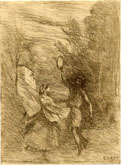
|
S. 223 x 163 mm
|
Saltarelle
Robaut 3194,
Delteil 75, Melot 75
glass print (cliché-verre)*, 1858, on fine cream
wove paper (papier salé), the
very rare first state (of 2), before the alterations in the plate to
the lower right (which appear in all later printings), a very fine
bistre impression, with rich contrasts, trimmed as usual to the border
line (the image complete), from the first printing by Charles Desavary;
a short tear extending into the composition upper left, expertly
mounted on a support sheet of vellum, otherwise in very good condition
|
Provenance: a private
Parisian collection
This fine print of Corot's
mature style depicts a verdant Italianate countryside landscape,
enlivened by a central pair of dancers. The saltarello
(from the Italian saltare, meaning "to leap")
was a popular North Italian dance dating back to the Renaissance,
which was still current in Corot's time.
Worked up in sketchy
refinement, the artist's graphic handling renders the subject
with a vibrant rhythm and resonant movement that oscillates between
realism, classicism, and romanticism.
It should further be
noted that there were no later printings of this work by either
Bouasse-Lebel or Sagot-Le Garrec.

* Technically speaking
the glass print (or cliché verre) was then an innovative
photographic medium invented by Constant Dutilleux and his son-in-law,
Charles Desavary. Taking a plate of glass coated with an opaque
layer of collodion, the artist would draw into the ground with
a sharp stylus, and then place the plate (as a sort of negative)
onto a photosensitive sheet of paper that, once exposed to light,
would be developed like a photograph. Corot first discovered this
process on a trip to Arras in 1853, and went on to create more
than 60 glass prints over the next 20 years.
This technique, given
the variables involved in preparing the paper, determining exposure
times, etc., resulted in a range of effects that were far more
difficult to control than those of more conventional printmaking
media. And it may even be surmised that Corot was intrigued by
such variety, which in turn fed his creative endeavour.


